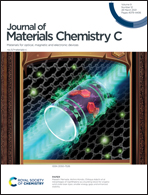Visual and dual-fluorescence homogeneous sensor for the detection of pyrophosphatase in clinical hyperthyroidism samples based on selective recognition of CdTe QDs and coordination polymerization of Ce3+†
Abstract
Here, we constructed a dual-fluorescence method for the detection of pyrophosphatase (PPase) using pyrophosphate–cerium coordination polymeric nanoparticles (PPi–Ce CPNs) and cadmium telluride quantum dots (CdTe QDs) as signal molecules. The dual fluorescence was achieved by a selective recognition reaction and a coordination polymerization reaction. On the one hand, QDs can selectively recognize Cu2+ and PPi–Cu2+–PPi complexes, which were formed by Cu2+ combining with PPi. On the other hand, Ce3+ can form PPi–Ce luminescent nanoparticles with PPi. Combined with the fact the PPase can hydrolyze PPi to Pi, it is expected to quantitatively analyze PPase, screen inhibitors of this enzyme, and be a clinical marker for hyperthyroidism diagnosis. The strategies with PPi–Ce CPNs and QDs as signal molecules both showed high sensitivity and good anti-interference, and the detection limits (LODs) were 0.15 and 0.8 U L−1, respectively. Analysis of 53 cases of clinical serum samples verified the accuracy and clinical applicability of the method, which showed consistent results in clinical diagnosis (thyroid stimulating hormone, free triiodothyronine 3, and free triiodothyronine 4). In addition, the visual analysis of PPase in 9 samples was successfully realized under UV light using QDs as the signal molecule, and it is easy to distinguish between normal people and hyperthyroid patients. After monitoring and comparing the content of PPase in clinical samples, we recommended 500 U L−1 of PPase as the threshold for diagnosis of hyperthyroidism. Therefore, the dual-fluorescence and visual homogeneous PPase analysis strategy can provide more options for clinical diagnosis of hyperthyroidism, which is expected to achieve point-of-care testing (POCT) for this disease in the future.



 Please wait while we load your content...
Please wait while we load your content...